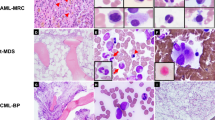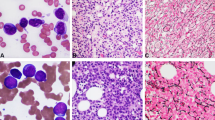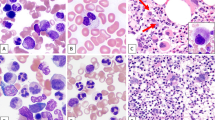Abstract
Among 11 JMML children, two had an abnormal karyotype, and nine had a normal karyotype at onset. In one patient with trisomy 8 and four patients with a normal karyotype, a new clone with an aberrant karyotype emerged 1–14 months after 6-mercaptopurine (6-MP) therapy as shown by G-banding analyses. Fluorescence in situ hybridization disclosed that an abnormal clone existed in approximately 3–6% of bone marrow cells at onset or before 6-MP therapy in all the four cases examined, and increased to approximately 12–90% during the treatment. In culture with granulocyte-macrophage colony-stimulating factor, cytogenetically abnormal clones that proliferated during 6-MP therapy possessed significantly less sensitivity to the antimetabolite, compared with cells that decreased in numbers after the therapy. A PTPN11 mutation was detected in all of granulocyte-macrophage colonies irrespective of karyotypic aberration in one patient, whereas approximately 80% of erythroid colonies and 20% of mixed colonies possessed neither a PTPN11 mutation nor chromosomal abnormalities. The appearance of chromosomal aberrations shown by G-banding during 6-MP therapy in some JMML cases may result, in part, from the growth of a 6-MP-refractory clone that already exists at onset. It is possible that treatment with 6-MP promotes progression of the disease.
This is a preview of subscription content, access via your institution
Access options
Subscribe to this journal
Receive 12 print issues and online access
$259.00 per year
only $21.58 per issue
Buy this article
- Purchase on Springer Link
- Instant access to full article PDF
Prices may be subject to local taxes which are calculated during checkout

Similar content being viewed by others
References
Niemeyer CM, Fenu S, Hasle H, Mann G, Stary J, van Wering E . Differentiating juvenile myelomonocytic leukemia from infectious disease. Blood 1998; 91: 365–367.
Tartaglia M, Niemeyer CM, Fragale A, Song X, Buechner J, Jung A et al. Somatic mutations in PTPN11 in juvenile myelomonocytic leukemia, myelodysplastic syndromes and acute myeloid leukemia. Nat Genet 2003; 34: 148–150.
Le DT, Kong N, Zhu Y, Lauchle JO, Aiyigari A, Braun BS et al. Somatic inactivation of Nf1 in hematopoietic cells results in a progressive myeloproliferative disorder. Blood 2004; 103: 4243–4250.
Side L, Taylor B, Cayouette M, Conner E, Thompson P, Luce M et al. Homozygous inactivation of the NF1 gene in bone marrow cells from children with neurofibromatosis type 1 and malignant myeloid disorders. N Engl J Med 1997; 336: 1713–1720.
Kalra R, Paderanga DC, Olson K, Shannon KM . Genetic analysis is consistent with the hypothesis that NF1 limits myeloid cell growth through p21ras. Blood 1994; 84: 3435–3439.
Niemeyer CM, Aricó M, Basso G, Biondi A, Cantu Rajnoldi A, Creutzig U et al. Chronic myelomonocytic leukemia in childhood: a retrospective analysis of 110 cases. European Working Group on Myelodysplastic Syndromes in Childhood (EWOG–MDS). Blood 1997; 89: 3534–3543.
Hasle H, Baumann I, Bergsträsser E, Fenu S, Fischer A, Kardos G et al. European Working Group on childhood MDS. The International Prognostic Scoring System (IPSS) for childhood myelodysplastic syndrome (MDS) and juvenile myelomonocytic leukemia (JMML). Leukemia 2004; 18: 2008–2014.
Lutz P, Zix-Kieffer I, Souillet G, Bertrand Y, Dhooge C, Rubie C et al. Juvenile myelomonocytic leukemia: analyses of treatment results in the EORTC Children's Leukemia Cooperative Group (CLCG). Bone Marrow Transplantation 1996; 18: 1111–1116.
Woods WG, Barnard DR, Alonzo TA, Buckley JD, Kobrinsky N, Arthur DC et al. Prospective study of 90 children requiring treatment for juvenile myelomonocytic leukemia or myelodysplastic syndrome: a report from the Children's Cancer Group. J Clin Oncol 2002; 20: 434–440.
Manabe A, Okamura J, Yumura-Yagi K, Akiyama Y, Sako M, Uchiyama H et al. MDS Committee of the Japanese Society of Pediatric Hematology. Allogeneic hematopoietic stem cell transplantation for 27 children with juvenile myelomonocytic leukemia diagnosed based on the criteria of the International JMML Working Group. Leukemia 2002; 16: 645–649.
Kosaki K, Suzuki T, Muroya K, Hasegawa T, Sato S, Matsuo N et al. PTPN11 (protein-tyrosine phosphatase, nonreceptor-type 11) mutations in seven Japanese patients with Noonan syndrome. J Clin Endocrinol Metab 2002; 87: 3529–3533.
Mitani K, Hangaishi A, Imamura N, Miyagawa K, Ogawa S, Kanda Y et al. No concomitant occurrence of the N-ras and p53 gene mutations in myelodysplastic syndromes. Leukemia 1997; 11: 863–865.
Kobayashi N, Matsuda K, Sakashita K, Matsuzaki S, Iwasaki R, Koike K . Bilineage acute leukemia of T-lymphoid and myeloid lineages. Haematologica 2004; 89: 1139–1141.
Sawai N, Koike K, Higuchi T, Ogami K, Oda M . Thrombopoietin enhances the production of myeloid cells, but not megakaryocytes, in juvenile chronic myelogenous leukemia. Blood 1998; 91: 4065–4073.
Sakashita K, Koike K, Kinoshita T, Shiohara M, Kamijo T, Taniguchi S et al. Dynamic DNA methylation change in the CpG island region of p15 during human myeloid development. J Clin Invest 2001; 108: 1195–1204.
Locatelli F, Nöllke P, Zecca M, Korthof E, Lanino E, Peters C et al. European Working Group on Childhood MDS; European Blood and Marrow Transplantation Group. Hematopoietic stem cell transplantation (HSCT) in children with juvenile myelomonocytic leukemia (JMML): results of the EWOG-MDS/EBMT trial. Blood 2005; 105: 410–419.
Acknowledgements
We thank Ms Yumiko Oguchi (Department of Pediatrics, Shinshu University School of Medicine) for the excellent technical assistance. This work was supported by Grants-in-Aid nos. 15790521 and 11670753 from the Ministry of Education, and by Grant-in-Aid for Cancer Research (16-3) from the Ministry of Health, Labour, and Welfare of Japan.
Author information
Authors and Affiliations
Corresponding author
Rights and permissions
About this article
Cite this article
Matsuda, K., Matsuzaki, S., Miki, J. et al. Chromosomal change during 6-mercaptopurine (6-MP) therapy in juvenile myelomonocytic leukemia: the growth of a 6-MP-refractory clone that already exists at onset. Leukemia 20, 485–490 (2006). https://doi.org/10.1038/sj.leu.2404106
Received:
Revised:
Accepted:
Published:
Issue Date:
DOI: https://doi.org/10.1038/sj.leu.2404106
Keywords
This article is cited by
-
In vitro expansion of CD34+CD38− cells under stimulation with hematopoietic growth factors on AGM-S3 cells in juvenile myelomonocytic leukemia
Leukemia (2015)
-
Myeloid progenitors with PTPN11 and nonRAS pathway gene mutations are refractory to treatment with 6-mercaptopurine in juvenile myelomonocytic leukemia
Leukemia (2014)



